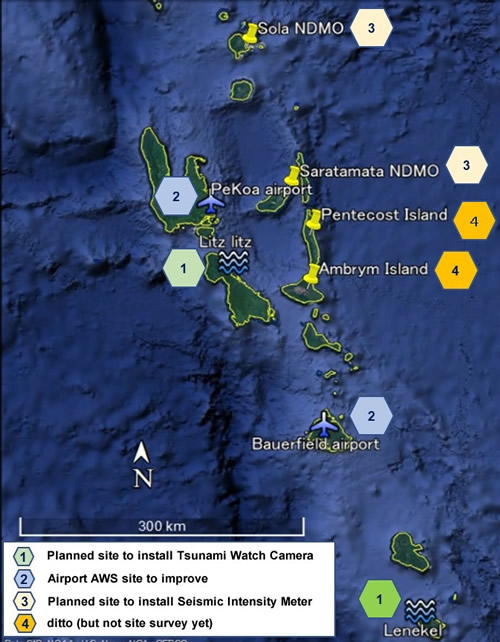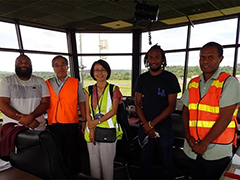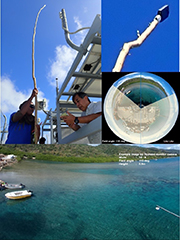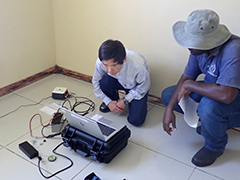- Home
- Technical Cooperation Projects
- Index of Countries
- Oceania
- Vanuatu
- Project for Enhanching the Capacity of Issuing Earthquake, Tsunami and Storm Surge Information
- Project News
- Site surveys to install Tsunami Watch Camera and Seismic Intensity Meter
Project News
2019-08-12
Site surveys to install Tsunami Watch Camera and Seismic Intensity Meter
To enhance the capacity of issuing Earthquake, Tsunami and Storm surge Information, the project is planning to install new Tsunami Watch Cameras and Seismic Intensity Meters in some islands of Vanuatu provinces. Before the installation, the site survey is essential to measure the sites and to confirm electricity, data communication, security and surrounding environment, etc. Therefore, the project team visited some islands from July to August 2019.
In order to conduct site surveys, the team brought portable Accelerograph Seismic Equipment, 360 degrees omnidirectional camera, laser measure, desktop computer, etc. as well as the measure and levelling rod. First and foremost, it is definitely necessary that the counterpart of Vanuatu Meteorological and Geo-hazards Department (VMGD) accompanies and operates with the team, as the "co-working" among counterparts and Japanese experts is essential for technical cooperation and they can assist the team by using their expertise, local knowledge and information.
 Place to install and install various types of equipment
Place to install and install various types of equipment
(1) Activity to improve the Automatic Weather Station (AWS) at Bauerfield airport Synop station (Efate island) (25th July 2019)
 Group photo at Air-traffic control building of Bauerfield airport
[ Air-traffic controllers (left end and 2nd from rigt), VMGD counterpert (right end)
Project team members (2nd and 3rd from left) ]
Group photo at Air-traffic control building of Bauerfield airport
[ Air-traffic controllers (left end and 2nd from rigt), VMGD counterpert (right end)
Project team members (2nd and 3rd from left) ]
The weather and earthquake information are essential for takeoff and landing of the aircrafts, resulting the tight cooperation between the department of aviation and VMGD.
The project team changed the AWS software at the Bauerfield airport Synop station to improve the display of precipitation. This was originally requested by the air-traffic controller who wanted to know the recent precipitation intensity. After this activity, the project team could get into the air-traffic control building to exchange the information with the air-traffic controller. This was because VMGD staff have been having a good relationship with them. The team eventually had a very good opportunity to discuss with them to facilitate the further activities.
(2) Site survey at Litz Litz tidal station (Malakula island) to install Tsunami Watch Camera (9th Aug. 2019)
 Scene of attaching the 360 degrees omnidirectional camera to the bare tree, and example view image of Tsunami Watch Camera
Scene of attaching the 360 degrees omnidirectional camera to the bare tree, and example view image of Tsunami Watch Camera
The unexpected issue occurred after the team arrived at the airport of Malakula island regarding the levelling rod. This tool is used to measure the height of lightning rod, and to confirm the visual performance and appropriate angle of view by mounting the 360 degrees omnidirectional camera on the tip of it.
The team eventually needed to survey without the levelling rod. In this troublesome situation, the counterpart was the one who solved the situation by bringing a 4.6m-long bare tree from nowhere. The 360 degrees omnidirectional camera was set on this bare tree with vinyl tape and it was used properly even it looked quite strange. Thanks of the wit of the counterpart, all work was done accordingly.
(3) Site survey to install real time seismometer at Sola (Vanua Lava island) (12th Aug. 2019)
 Noise measurement by the portable Accelerograph Seismic Equipment
Noise measurement by the portable Accelerograph Seismic Equipment
The team conducted the survey to measure the seismic noise, and to confirm electricity, data communication, and surrounding environment, etc. at National Disaster Management Office(NDMO) and e-Government data centre in Sola as the possible locations of equipment. There were some issues such as the walls covered by mold; moreover, there was no commercial electricity around even the power lines and electrical meters were installed. The reasons why the situations were like these, were the NDMO building had flood inside before and the electrical company has been taking a long time to finish all procedures, which the counterpart taught the team. The team re-confirmed the presence of counterparts who know the local knowledge and information, to work with, especially in the site survey.
For the installation of equipment as well as the technical transfer, it is essential to collaborate with the counterparts.
The team tries to keep a good relationship with counterparts and aim to achieve the project purpose in the future.
Project Expert (Disaster Information)
Hiroyuki Ichijo (Mr.)
- About JICA
- News & Features
- Countries & Regions
- Our Work
- Thematic Issues
- Types of Assistance
- Partnerships with Other Development Partners
- Climate Change / Environmental and Social Considerations
- Evaluations
- Compliance and Anti-corruption
- Science and Technology Cooperation on Global Issues
- Research
- JICA Development Studies Program / JICA Chair
- Support for the Acceptance of Foreign HRs / Multicultural and Inclusive Community
- Publications
- Investor Relations
